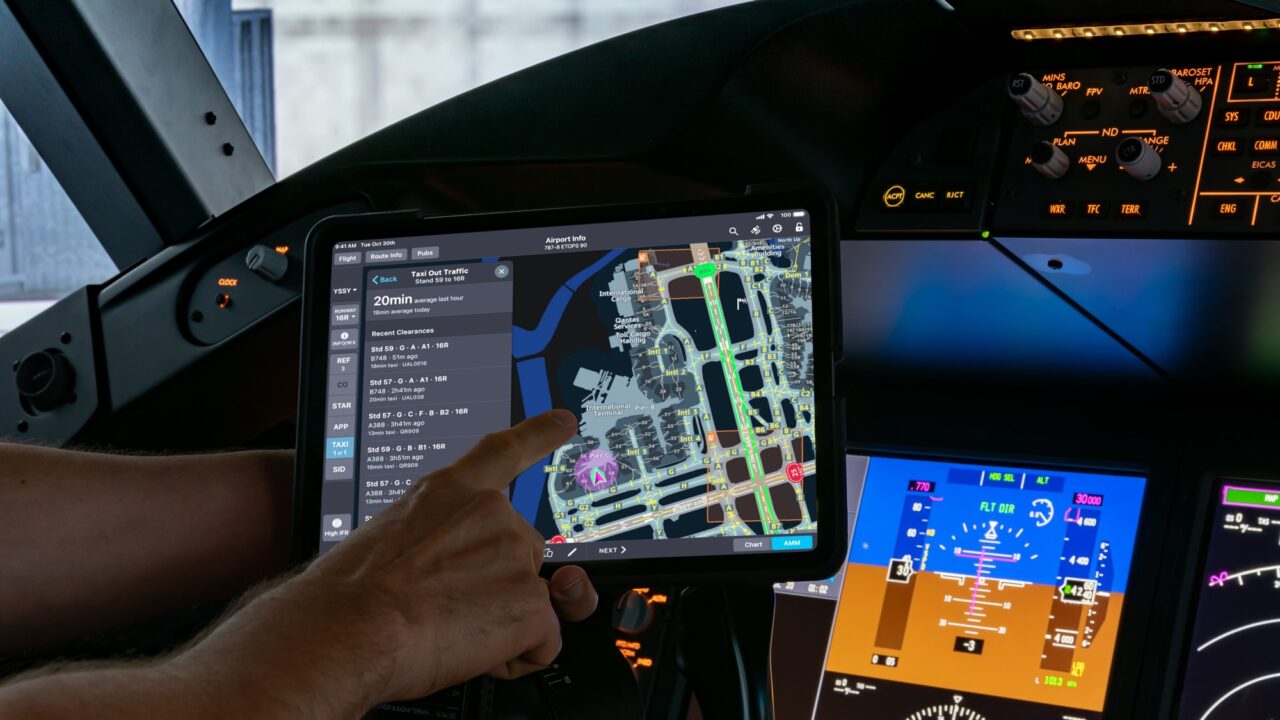
Boeing’s 2022 777-200 ecoDemonstrator program is testing out two new digital capabilities—Taxi Time Information and Taxi Clearance—which are designed to help airlines reduce turnaround times on the ground and eliminate fuel-burning delays. (Photo courtesy of Boeing)
Boeing is testing two new digital capabilities—Taxi Time Information and Taxi Clearance—on its ecoDemonstrator 777-200 program that can improve the way airline pilots anticipate the amount of time they will need to spend taxiing around airports during the pre-departure or post-landing process. In emailed statements to Avionics International, several experts from Boeing Global Services explained how these two capabilities use aircraft connectivity and ADS-B positioning data to calculate estimated required taxi times on a per-airport basis.
The purpose of testing the Taxi Time Information and Taxi Clearance digital capabilities is to give flight crews improved predictability for the pre-departure or landing process by reducing the amount of time they spend taxiing around the airport waiting on clearances for takeoff or to roll into a parking stand for deplaning.
“To implement reduced engine taxi operations and reduce fuel consumption, the flight deck crew must accurately predict the taxi time needed between their runway and parking stand. Pilots tell us this is difficult, because the historical averages used today are insufficient for accurate decision-making in real-life situations,” Marco Gärtner, Senior Product Manager, Boeing Global Services, said in an emailed statement.
Taxi Time Information, for example, is an application programmable interface compatible with the Jeppesen FliteDeck Pro app—or other third party EFB applications—that uses ADS-B positioning data to anticipate inbound or outbound clearance and taxi times for flight crews. This is one of the two tablet-based digital airport mapping capabilities Boeing is testing on its ecoDemonstrator program.
Optimizing the way airlines time their reduced thrust engines-on rollout to the runway in preparation for air traffic control clearance to takeoff has been a major focus of civil aviation authorities, airports, and airlines over the last decade.
Leadership at Schiphol Airport in the Netherlands announced a unique approach to reducing the amount of fuel burned by aircraft engines while taxiing there by investing in TaxiBots—special towing vehicles that take aircraft to and from the runway allowing engines to mostly remain switched off.
Last year, the Federal Aviation Administration (FAA) rolled out an air traffic system software update to its Terminal Flight Data Manager (TFDM) system that improves the way air traffic controllers calculate the best time for gate pushbacks at busy hub airports to occur so that each plane can roll directly to the runway and take off with little to no intermittent stopping. The FAA introduced the capability at 27 hub airports in the U.S. last year.
Boeing aims to give pilots improved taxi time prediction analysis within their tablet-based airport moving map applications. Using their preferred EFB application with the Taxi Time Information capability, a pilot enters their assigned runway in the application and immediately sees the average taxi time from their assigned runway to parking stand that day, or even a particular hour, according to Gärtner.

The 2022 ecoDemonstrator program is a Boeing 777-200ER, pictured here at the 2022 EAA AirVenture show earlier this year in Oshkosh, Wisconsin. (Photo courtesy of Boeing)
“The capability uses Automatic Dependent Surveillance–Broadcast (ADS-B) position data from a third-party aggregator, a surveillance technology in which an aircraft determines its position via satellite navigation or other sensors and periodically broadcasts it, enabling it to be tracked. This live data, which is usually available within two minutes, is combined with Jeppesen airport maps to produce a record of current taxi events at an airport,” he said.
One of the prerequisite aircraft equipment requirements for enabling Taxi Time, according to Gärtner, is connectivity.
“COVID caused airlines to pause many projects, including those regarding connectivity,” he said. “Now, after the pandemic, flight numbers have recovered and some are even higher than in 2019. Many airlines have mentioned they have revived cockpit connectivity projects.”
The Taxi Clearance capability has a focus on improving airport navigation, by giving flight crews the ability to quickly record their cleared taxi route and view it as a digital guide to the runway within their preferred airport mapping application.
“Today, when pilots receive their cleared taxi route, they often write the instructions down and then mentally create or physically draw the pathway on their terminal chart,” Gärtner said. “With the Taxi Clearance capability, flight deck crew simply touch the taxiways listed by Air Traffic Control (ATC) in their app, and the route is automatically visualized on their digital map.”
BGS’s digital aviation solutions team estimates that airlines spend up to 25% of their operating budget on fuel. The latest FAA data shows that the average time spent taxiing into and out of airports is between 16 to 27 minutes.
Gärtner confirmed that that BGS already has the ability to update the Jeppesen FliteDeck Pro application with the Taxi Time and Information API’s ability to report historical and real-time taxi times. One new capability Boeing is researching is providing recommendations for single engine taxi and other fuel-saving ground-maneuvering tactics for pilots.
“Looking to the future, our next task will be to provide predictive analytics that could even recommend when pilots should taxi with a single engine, when the engines should warm up, and when the second engine should be started, based on the expected time to the runway, actual lineup time and other real-time data,” Gärtner said.